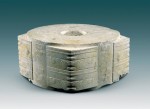Jade artifacts of the Liangzhu culture – 1
 A jade cong produced 3,300-2,200 years ago, a typical art object of the Liangzhu culture. For its size, it is dubbed as “king of all congs”” width=”90″ height=”65″ />Back in the early 20t h century, in Shanghai, adventurers and merchants from the West were able to buy some jade artifacts unique in shape and strange in design. One is a long hollow piece of jade carved with images so strange that it was difficult, if not impossible, to tell whether they were human or supernatural. People had no idea of where, when and for what purpose the jade piece was produced, including even the person who sold it.
A jade cong produced 3,300-2,200 years ago, a typical art object of the Liangzhu culture. For its size, it is dubbed as “king of all congs”” width=”90″ height=”65″ />Back in the early 20t h century, in Shanghai, adventurers and merchants from the West were able to buy some jade artifacts unique in shape and strange in design. One is a long hollow piece of jade carved with images so strange that it was difficult, if not impossible, to tell whether they were human or supernatural. People had no idea of where, when and for what purpose the jade piece was produced, including even the person who sold it.
Two or three decades later, in Yuhang County of Zhejiang Province, east  China, archeologists found some jade artifacts identical in shape and design to the piece mentioned in the proceeding paragraph, but they were still at a loss for when such objects were produced. It was not until the 1980s did experts conclude that these relics belong to the Liangzhu culture dating back to 3,500-4,000 years ago in some areas on the lower reaches of the Yangtze River. This came after excavations on Mt. Caoxie and Mt. Zhangling in Wuxian County, Jiangsu Province, during which numerous jade artifacts of the Neolithic Age were found, including cong (long, hollow pieces with triangular sides), bi (round piece with a hole in the middle), as well as yue (battle-ax). Likewise, the Shanghai jade piece sold in the early 20th century was identified as a typical art object of the Liangzhu culture.
China, archeologists found some jade artifacts identical in shape and design to the piece mentioned in the proceeding paragraph, but they were still at a loss for when such objects were produced. It was not until the 1980s did experts conclude that these relics belong to the Liangzhu culture dating back to 3,500-4,000 years ago in some areas on the lower reaches of the Yangtze River. This came after excavations on Mt. Caoxie and Mt. Zhangling in Wuxian County, Jiangsu Province, during which numerous jade artifacts of the Neolithic Age were found, including cong (long, hollow pieces with triangular sides), bi (round piece with a hole in the middle), as well as yue (battle-ax). Likewise, the Shanghai jade piece sold in the early 20th century was identified as a typical art object of the Liangzhu culture.
Jade artifacts of the Liangzhu culture are found mainly in Jiangsu, Zhejiang  and Anhui provinces on the lower reaches of the Yangtze River. A social estate system was already in place in these areas when these were produced, under which the privileged depended, in addition to forces of arms, on divine power and witchcraft to run roughshod over their subjects, the majority of the local people. That may explain why we attribute most jade artifacts of the Liangzhu culture – cong, bi as well as objects that take the shape of hats, semi-circles or three-throng spears to primitive witchcraft and worshipping of the supernatural. As a matter of fact, these artifacts are often geometrical in shape with symmetrical patterns engraved on them, in a style that denotes solemnity. While the largest in size, Cong pieces– those long, hollow pieces with triangular sides –outnumber jade artifacts of all other types belonging to the Liangzhu culture.
and Anhui provinces on the lower reaches of the Yangtze River. A social estate system was already in place in these areas when these were produced, under which the privileged depended, in addition to forces of arms, on divine power and witchcraft to run roughshod over their subjects, the majority of the local people. That may explain why we attribute most jade artifacts of the Liangzhu culture – cong, bi as well as objects that take the shape of hats, semi-circles or three-throng spears to primitive witchcraft and worshipping of the supernatural. As a matter of fact, these artifacts are often geometrical in shape with symmetrical patterns engraved on them, in a style that denotes solemnity. While the largest in size, Cong pieces– those long, hollow pieces with triangular sides –outnumber jade artifacts of all other types belonging to the Liangzhu culture.